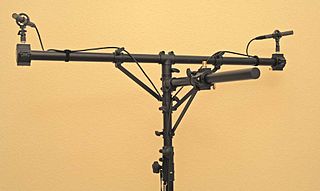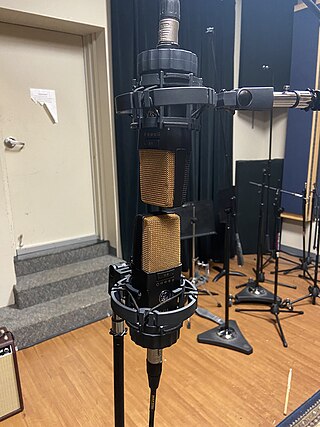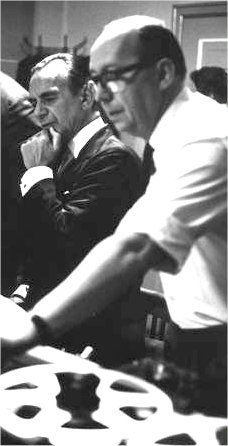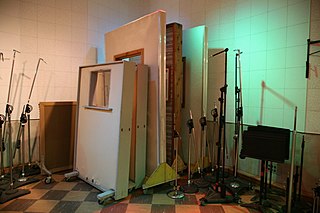Overhead positioning
There are multiple arrangements for drum overheads, which are often based on personal preference of the musician, engineer, or producer. [1] These include "A-B" spaced pairs (where two directional microphones are suspended above the left and right clusters of cymbals), [1] "X-Y" coincident pairs, where the two directional microphones are centred on the drum kit with their capsule are very close without touching, and angled across each other at 90°. [3] Coincident placement give a wider stereo image than spaced pairs, and some engineers prefer it for this reason. [4]
Other drum overhead positions include the Recorderman Technique (where the distance between both microphones and the snare drum is equal, as is the distance between both microphones and the bass drum [5] ) and the Glyn Johns method (where one "overhead" is placed to the drummer's right, aiming across the floor tom to the centre of the kit [6] ).
In orchestral recordings, particularly those for film score recordings, the Decca tree is often used. [7]

A microphone, colloquially called a mic, or mike, is a transducer that converts sound into an electrical signal. Microphones are used in many applications such as telephones, hearing aids, public address systems for concert halls and public events, motion picture production, live and recorded audio engineering, sound recording, two-way radios, megaphones, and radio and television broadcasting. They are also used in computers and other electronic devices, such as mobile phones, for recording sounds, speech recognition, VoIP, and other purposes, such as ultrasonic sensors or knock sensors.

Surround sound is a technique for enriching the fidelity and depth of sound reproduction by using multiple audio channels from speakers that surround the listener. Its first application was in movie theaters. Prior to surround sound, theater sound systems commonly had three screen channels of sound that played from three loudspeakers located in front of the audience. Surround sound adds one or more channels from loudspeakers to the side or behind the listener that are able to create the sensation of sound coming from any horizontal direction around the listener.

A sound reinforcement system is the combination of microphones, signal processors, amplifiers, and loudspeakers in enclosures all controlled by a mixing console that makes live or pre-recorded sounds louder and may also distribute those sounds to a larger or more distant audience. In many situations, a sound reinforcement system is also used to enhance or alter the sound of the sources on the stage, typically by using electronic effects, such as reverb, as opposed to simply amplifying the sources unaltered.

Stereophonic sound, or more commonly stereo, is a method of sound reproduction that recreates a multi-directional, 3-dimensional audible perspective. This is usually achieved by using two independent audio channels through a configuration of two loudspeakers in such a way as to create the impression of sound heard from various directions, as in natural hearing.
The Soundfield microphone is an audio microphone composed of four closely spaced subcardioid or cardioid (unidirectional) microphone capsules arranged in a tetrahedron. It was invented by Michael Gerzon and Peter Craven, and is a part of, but not exclusive to, Ambisonics, a surround sound technology. It can function as a mono, stereo or surround sound microphone, optionally including height information.

Field recording is the term used for an audio recording produced outside a recording studio, and the term applies to recordings of both natural and human-produced sounds. It also applies to sound recordings like electromagnetic fields or vibrations using different microphones like a passive magnetic antenna for electromagnetic recordings or contact microphones. For underwater field recordings, a field recordist uses hydrophones to capture the sounds and/or movements of whales, or other aquatic organisms. These recordings are very useful for sound designers.

The Nederlandse Omroep Stitchting (NOS) stereo technique is a method of capturing stereo sound.

The Decca Tree is a spaced microphone array most commonly used for orchestral recording. It was originally developed as a sort of stereo A–B recording method adding a center fill. The technique was developed in the early 1950s and first commercially used in 1954 by Arthur Haddy, Roy Wallace, and later refined by engineer Kenneth Ernest Wilkinson and his team at Decca Records and its recording studios, to provide a strong stereo image.

Blumlein pair is a stereo recording technique invented by Alan Blumlein for the creation of recordings that, upon replaying through headphones or loudspeakers, recreate the spatial characteristics of the recorded signal.

There are a number of well-developed microphone techniques used for recording musical, film, or voice sources or picking up sounds as part of sound reinforcement systems. The choice of technique depends on a number of factors, including:
David Miles Huber is an American composer and producer in the downtempo, ambient and dance genres. He is also the author of numerous books on recording and electronic music. Huber's CD series Relaxation and Meditation with Music and Nature has sold over one million copies. His latest music and collaborations are available through the 51bpm independent record label. Huber's most prominent book, Modern Recording Techniques, has sold over 250,000 copies and become a standard recording industry text.
Phase 4 Stereo was a recording process created by the U.K. Decca Records label in 1961. The process was used on U.K. Decca recordings and also those of its American subsidiary London Records during the 1960s.
Ambiophonics is a method in the public domain that employs digital signal processing (DSP) and two loudspeakers directly in front of the listener in order to improve reproduction of stereophonic and 5.1 surround sound for music, movies, and games in home theaters, gaming PCs, workstations, or studio monitoring applications. First implemented using mechanical means in 1986, today a number of hardware and VST plug-in makers offer Ambiophonic DSP. Ambiophonics eliminates crosstalk inherent in the conventional stereo triangle speaker placement, and thereby generates a speaker-binaural soundfield that emulates headphone-binaural sound, and creates for the listener improved perception of reality of recorded auditory scenes. A second speaker pair can be added in back in order to enable 360° surround sound reproduction. Additional surround speakers may be used for hall ambience, including height, if desired.

Kenneth Ernest Wilkinson was an audio engineer for Decca Records, known for engineering classical recordings with superb sound quality.

In sound recording and reproduction, audio mixing is the process of optimizing and combining multitrack recordings into a final mono, stereo or surround sound product. In the process of combining the separate tracks, their relative levels are adjusted and balanced and various processes such as equalization and compression are commonly applied to individual tracks, groups of tracks, and the overall mix. In stereo and surround sound mixing, the placement of the tracks within the stereo field are adjusted and balanced. Audio mixing techniques and approaches vary widely and have a significant influence on the final product.

Spill is the occurrence in sound recording and live sound mixing whereby sound is picked up by a microphone from a source other than that which is intended. Spill is usually seen as a problem, and various steps are taken to avoid it or reduce it. In some styles of music, such as orchestral music, jazz, and blues, it is more likely to be accepted or even seen as desirable.

The Coles 4038 is a ribbon microphone produced by Coles Electroacoustics. The microphone was designed and patented by the BBC in the 1950s and was originally known as the STC 4038. The sound of the microphone has been described as "British" with a "BBC politeness", and its appearance has been likened to that of a waffle iron. It is used in both sound recording and radio broadcasting.

Remote recording, also known as location recording, is the act of making a high-quality complex audio recording of a live concert performance, or any other location recording that uses multitrack recording techniques outside of a recording studio. The multitrack recording is then carefully mixed, and the finished result is called a remote recording or a live album. This is in contrast to a field recording which uses few microphones, recorded onto the same number of channels as the intended product. Remote recording is not the same as remote broadcast for which multiple microphones are mixed live and broadcast during the performance, typically to stereo. Remote recording and remote broadcast may be carried out simultaneously by the same crew using the same microphones.

The United Kingdom patent 394325 'Improvements in and relating to Sound-transmission, Sound-recording and Sound-reproducing Systems' is a fundamental work on stereophonic sound, written by Alan Blumlein in 1931 and published in 1933. The work exists only in the form of a patent and two accompanying memos addressed to Isaac Shoenberg. The text is exceptionally long for a patent of the period, having 70 numbered claims. It contains a brief summary of sound localization theory, a roadmap for introduction of surround sound in sound film and recording industry, and a description of Blumlein's inventions related to stereophony, notably the matrix processing of stereo signals, the Blumlein stereo microphone and the 45/45 mechanical recording system.

The Sennheiser MD 421 is a German cardioid dynamic microphone, widely used for speech in broadcasting and for music in live concerts and the recording studio. Introduced in 1960, the internal large-diaphragm transducer element of the MD 421 is still produced unchanged by Sennheiser. The MD 421 is considered a classic, an industry standard. More than 500,000 units have been sold.

















